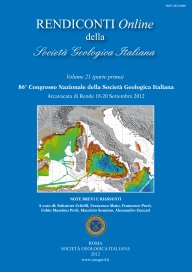
GPS velocity and strain fields in Sicily and southern Calabria, Italy: updated geodetic constraints on tectonic block interaction in the central Mediterranean
Mimmo Palano (*), Luigi Ferranti (**), Carmelo Monaco (°), Mario Mattia (*), Marco Aloisi (*), Valentina Bruno (*), Flavio Cannavò (*) & Giuseppe Siligato (°°)
(*) Istituto Nazionale di Geofisica e Vulcanologia, Osservatorio Etneo, Sezione di Catania.
(**) Dipartimento di Scienze Biologiche, Geologiche e Ambientali, Sezione di Scienze della Terra, Università di Catania.
(°) Dipartimento di Scienze della Terra, Università di Napoli Federico II°.
(°°) Leica Geosystems.
Volume: 21/2012
Pages: 235-237
Abstract
We present an improved rendition of the geodetic velocity and strain fields in Sicily and southern Calabria obtained through the analysis of 18 years of GPS observations from networks of continuous and survey stations. The dense spatial coverage of geodetic data provides precise quantitative estimates of previously established first-order active kinematic features, including: i) a narrow east-west-elongated belt of contraction (~1-1.5 mm/yr) extending offshore northern Sicily from Ustica to Stromboli across the Aeolian Islands; ii) a narrow east-west-trending contractional belt (shortening occurs at ~4.4 mm/yr) located along the northern rim of the Hyblean Plateau in southern Sicily; iii) transpression and transtension partitioned across discrete sectors of the Aeolian-Tindari-Letojanni fault (ATLF) system, a main shear zone extending from the Aeolian Islands to the Ionian coast of Sicily; iv) transtension (~1 mm/yr) across the Sicily Channel between Sicily and North Africa. We use geodetic observations coupled to geological constraints to better elucidate the interplay of crustal blocks revealed in the investigated area.
In particular, we focus on the ATLF, which forms the primary boundary between the Sicilian and Calabrian blocks. The ATLF juxtaposes north-south contraction between Sicily and the Tyrrhenian block with NW-SE extension in north-eastern Sicily and Calabria. Contraction between Sicily and Tyrrhenian blocks probably arises from the main Europe-Nubia convergence, although Sicily has a component of lateral escape from Nubia. We found that convergence is not restricted to the northern offshore, as commonly believed, but is largely accommodated between the frontal belt and the northern rim of the Hyblean foreland in southern Sicily. Geodetic data also indicate that active right shear on the ATLF (~3.6 mm/yr) occurs to the southeast of the mapped fault array, suggesting the fault cut through Sicily till its Ionian coast. The small geodetic divergence between the Hyblean and Apulian blocks rimming on both sides the Calabria accretionary prism, coupled with marine geophysical evidences in the Ionian Sea lends credit to the proposed deep root of the ATLF and to a fragmentation of the Ionian domain.
Keywords
Get Full Text